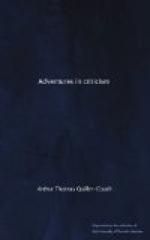“the beautiful representation of a life of unexampled misfortunes, and of a variety not to be met with in the world, sincerely adapted to and intended for the common good of mankind, and designed at first, as it is now further applied, to the most serious use possible. Farther, that there is a man alive, and well known too, the actions of whose life are the just subject of these volumes, and to whom all or most part of the story most directly alludes; this may be depended upon, for truth, and to this I set my name.”
He proceeds to assert this in detail of several important passages in the book, and obviously intends us to infer that the adventures of Robinson Crusoe of York, Mariner, were throughout and from the beginning designed as a story in parable of the life and adventures of Daniel Defoe, Gentleman. “But Defoe may have been lying?” This was never quite flatly asserted. Even his enemy Gildon admitted an analogy between the tale of Crusoe and the stormy life of Defoe with its frequent shipwrecks “more by land than by sea.” Gildon admitted this implicitly in the title of his pamphlet, The Life and Strange Surprising Adventures of Mr. D—— De F——, of London, Hosier, who has lived above Fifty Years by himself in the Kingdoms of North and South Britain. But the question has always been, To what extent are we to accept Defoe’s statement that the story is an allegory? Does it agree step by step and in detail with the circumstances of Defoe’s life? Or has it but a general allegorical resemblance?
Hitherto, critics have been content with the general resemblance, and have agreed that it would be a mistake to accept Defoe’s statement too literally, to hunt for minute allusions in Robinson Crusoe, and search for exact resemblances between incidents in the tale and events in the author’s life. But this at any rate may be safely affirmed, that recent discoveries have proved the resemblance to be a great deal closer than anyone suspected a few years ago.
Mr. Wright’s hypothesis.
Mr. Aitken supplied the key when he announced in the Athenaeum for August 23rd, 1890, his discovery that Daniel Defoe was born, not in 1661 (as had hitherto been supposed), but earlier, and probably in the latter part of the year 1659. The story dates Crusoe’s birth September 30th, 1632, or just twenty-seven years earlier. Now Mr. Wright, Defoe’s latest biographer,[A] maintains that if we add these twenty-seven years to the date of any event in Crusoe’s life we shall have the date of the corresponding event in Defoe’s life. By this simple calculation he finds that Crusoe’s running away to sea corresponds in time with Defoe’s departure from the academy at Newington Green; Crusoe’s early period on the island (south side) with the years Defoe lived at Tooting; Crusoe’s visit to the other side of the island with a journey of Defoe’s into Scotland; the footprint and the arrival of the savages with the threatening letters received by Defoe, and the physical assaults made on him after the Sacheverell trial; while Friday stands for a collaborator who helped Defoe with his work.




